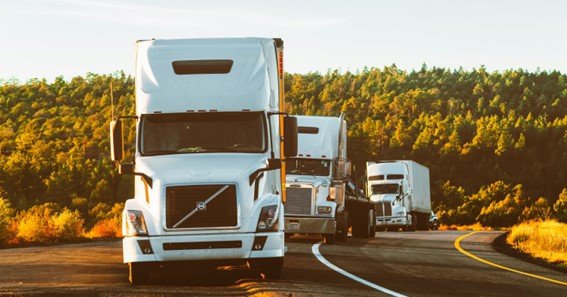Artificial Intelligence(AI), through its advanced predictive analytics and real-time monitoring, is helping the trucking businesses. It can identify potential risks even before accidents occur. From detecting driver fatigue to optimizing routes and improving vehicle maintenance, AI-powered systems are designed to minimize human error and prevent dangerous situations.
In this article, we will discuss how this technology evolves and promises to make trucking safer, reduce accidents, and increase overall efficiency.
Understanding AI’s Role in the Trucking Industry
The trucking industry is a massive global force, moving billions of tons of goods annually and serving as the backbone of modern economies. According to the American Truck Association, the trucking businesses have employed 8.5 million workers. The trucking economy includes jobs related to trucking activities, especially driving. There were 3.55 million truck drivers employed in the US in 2023.
AI has played a pivotal role in trucking, particularly in the last decade, by enhancing route optimization, improving fuel efficiency, and reducing accidents. Since the AI-driven solutions, trucking companies have leveraged these innovations to automate tasks, increase safety, and address challenges like driver shortages and regulatory demands.
Real-Time Monitoring and Driver Assistance Systems
Real-time monitoring in trucking refers to the use of AI-powered systems that continuously track vehicle performance, driver behavior, and road conditions. By analyzing data in real-time, these systems provide instant feedback to truck drivers, helping them make safer decisions on the road.
The National Insurance Crime Bureau reported 582 cases of cargo thefts in the US and Canada in the 2nd quarter of 2023. Shipments worth $44 million were stolen at the same time. The cargo thieves aimed for shipments with higher value. Real-time monitoring can reduce the chances of theft and can also prevent trucks from cargo thefts.
Real-time monitoring can detect signs of driver fatigue, issue warnings for lane departures, and alert drivers about potential hazards ahead. Additionally, driver aid systems, like adaptive cruise control and automated braking, enhance safety by reducing human error and preventing collisions. This makes trucking more efficient and secure for drivers and other road users.
What role do AI-based cameras and sensors play in accident prevention?
AI-based cameras and sensors may prevent accidents by continuously monitoring a truck’s surroundings and driver behavior. They detect obstacles, unsafe driving patterns, and potential crash risks in real-time, triggering alerts or motorized actions like braking to avoid accidents. These systems help reduce human error, enhancing overall road safety.
Predictive Maintenance and Accident Prevention
Predictive maintenance now uses AI to analyze vehicle data, identifying potential mechanical problems before they lead to rots or accidents.
By predicting when components like brakes or tires need repair, AI systems help trucking companies maintain vehicles proactively, minimizing the risk of failures. This approach not only prevents accidents but also reduces downtime and repair costs, ensuring that trucks operate efficiently and safely over longer periods.
For instance, last week, the westbound Interstate 270 witnessed a multi-vehicle wreck and a truck catching blaze near the Chain of Rocks Bridge. Due to this incident, the lane was closed for many hours, as reported by First Alert 4. The Illinois, St Louis, State Police Department stated a semi-truck caught fire, prompting another semi-truck to halt behind it, with two cars trailing closely.
However, a third semi-truck failed to stop, resulting in a cascading rear-end collision. Traffic cameras captured images of dark smoke rising from the vicinity of the incident on the Illinois side of the river.
In this case, predictive maintenance could have identified the maintenance issues. It could have allowed for timely repairs that would have kept the truck operating smoothly and prevented the fire.
In these types of situations, a St. Louis truck accident lawyer can help determine who is truly responsible for the accident. The complexities of such accidents often involve multiple parties, including truck drivers, trucking companies, and vehicle manufacturers.
Engaging a skilled attorney ensures that all angles are explored, potentially uncovering negligence or violations of safety regulations, states TorHoerman Law. This thorough investigation can lead to better accountability and compensation for those affected by the accident.
Is predictive maintenance affordable for small trucking companies?
Yes, modern AI technology is progressing and becoming more accessible to small businesses. According to Scoop Market, predictive maintenance can save up to 30-40% over reactive maintenance techniques. Cloud-based platforms and scalable solutions allow even smaller fleets to adopt predictive maintenance tools, helping them save on costly repairs.
AI in Fleet Management and Route Optimization
AI plays a transformative role in fleet management and route optimization by leveraging vast amounts of data to enhance operational efficiency. By examining traffic patterns, weather circumstances, and delivery schedules, AI can determine the most feasible routes, minimizing fuel consumption and reducing travel time.
This not only saves money but also improves customer pleasure by ensuring timely deliveries. Additionally, AI helps fleet managers monitor vehicle performance and driver behavior, facilitating proactive maintenance and safety interventions. Ultimately, the integration of AI in fleet management leads to a more streamlined, cost-effective, and sustainable trucking operation.
Can AI reroute trucks in real time to avoid bad weather or traffic?
Yes, AI can reroute trucks in real time by continuously analyzing data from diverse sources, including traffic reports and weather forecasts. This capability allows fleet management systems to dynamically adjust routes, ensuring that drivers take secure and the most efficient paths.
AI and Autonomous Trucking
AI is at the forefront of the evolution toward autonomous trucking, revolutionizing how goods are transported. Through developed machine learning algorithms and sensor technologies, autonomous trucks can navigate complex environments, make real-time decisions, and adjust to changing road situations.
According to Fortune Business Insights, the international autonomous trucking market volume was $33 billion in 2023. It is expected to surge at a CAGR of 10% during the assessment period and become $76.01 billion by 2032.
The major driving factor of this market is human errors. This technology promises to enhance safety by reducing human error, optimizing fuel efficiency, and addressing driver shortages in the industry.
While fully autonomous trucks are still in evolution, AI is progressively being integrated into semi-autonomous systems. It is paving the way for a future where self-driving automobiles play a substantial role in the logistics and transportation sectors.
The Role of AI in Training and Educating Truck Drivers
AI plays a vital role in training and educating truck drivers by providing immersive, personalized learning experiences that enhance safety and efficiency. Advanced simulation technologies powered by AI allow trainees to practice driving in various scenarios, including challenging weather and unexpected road situations, without real-world risks.
Additionally, AI-driven analytics can assess a driver’s performance, identifying areas for improvement and tailoring training programs to meet individual needs. By integrating AI into driver education, trucking companies can cultivate a more skilled workforce, reduce accidents, and ensure that drivers are well-prepared.
Overcoming Challenges in AI Implementation
Implementing AI in the trucking industry presents several challenges that must be addressed for successful integration. One noteworthy hurdle is the initial cost of AI technologies, which can be prohibitive for smaller companies.
Additionally, the complexity of incorporating AI systems with existing vehicles requires careful planning and skilled personnel, often leading to a steep learning curve.
Resistance to change from employees conditioned to conventional methods can also hinder adoption. To overcome these challenges, trucking companies should invest in training, start with pilot programs, and gradually scale AI solutions,
Embracing the Future of Trucking
As AI continues to shape the trucking industry, its potential to enhance safety, efficiency, and driver training is undeniable. By overcoming implementation challenges and embracing innovative technologies, trucking companies can pave the way for a safer, more efficient future. The integration of AI not only benefits businesses but also provides a safer road for everyone.










